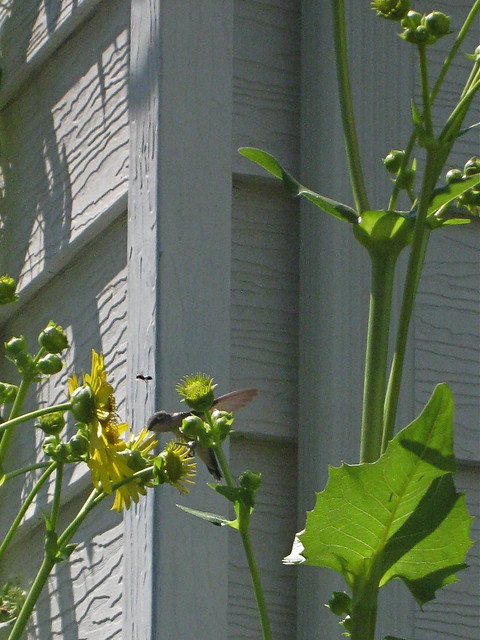As my garden renovation proceeds, I removed a Sweet Autumn Clematis (Clematis terniflora) from one of my witch hazel trees. Nasty work in this heat, but I'm finally getting serious about removing the invasive alien plants in my yard. Sweet Autumn Clematis has just about engulfed the Sugar Creek area of Kirkwood, Missouri, but I think I'll make that the subject of a later post. Just as I stretched out atop the ladder to remove that last bit of vine shading my puny little witch hazel, I had a moment of panic. A hummingbird—a female-plumaged Ruby-throated Hummingbird—frantically bounced around the tip of a top branch. Had I accidently destroyed her nest?
I've never had a hummingbird nest in my yard, in spite of the fact that I've done as much as I can to attract them to my garden, including mounting Dan True's "Hummingbird House." Also, it's pretty late in summer for a hummingbird to have an active nest. I searched, but found no evidence of a nest among the piles of vines below. So what was she doing?
I took these photo on July 17, just as my Cup Plants (Silphium perfoliatum) were beginning to bloom. Is this female Ruby-throat getting nectar from the bloom, as butterflies do?
She certainly seems to be. Daisy-like composite blooms aren't described as hummingbird flowers in the books. Like the Pipevine Swallowtail butterflies that visit my Royal Catchfly, hummingbirds don't read the books.
Or are there some insects within the bloom that she's lapping up? I remember reading Bob Sargent's quote on Hummingbirds.net: "Hummers need nectar to power the bug-eating machine that they are." Bob Sargent is a well-known hummingbird bander and author. He was interviewed on Richard and Susan Day's Daybreak Blog.
Since I spotted the hummer at my witch hazel, I've seen others busy at things that make no sense to me. I noticed one bobbing up and down on the tips of a cedar tree (Juniperus virginiana) where I don't think there can be any nectar.
Hummingbirds use a display flight to attract a mate or drive out an intruder, but these displays typically cover more than ten feet of vertical air space. The movement I described covered only a few inches.
I assume hummingbirds don't have energy to waste, so their activity must have some purpose. I wonder what it was…
You might also enjoy:
 |
| Royal Catchfly |
 |
| Hole in One |
 |
| Golden Currant |


Lovely bird. But are you serious about being outside in this weather? I've heard it's roasting there!
ReplyDeleteCrazy hot! I just can't water the garden enough. I stay out long enough to water the pots or snap a photo, then it's back to the cave. Cup plants have been doing well though.
ReplyDeleteHummers don't give up their secrets easily! I hope you're staying cool. We got a bit of a break today--it's only 89°F! Jealous?
ReplyDeleteI saw one in my yard drinking nectar from a huckleberry bush. I was surprised- the flowers are so tiny.
ReplyDeleteI don't know of any thorough study of nectar, but here is an article about some garden plants and their sugar concentration/quantity in Louisiana Ornithological Society's newsletter (page 7). I guess even tiny blossoms like huckleberry could have nectar with a high concentration of sugar.
ReplyDelete